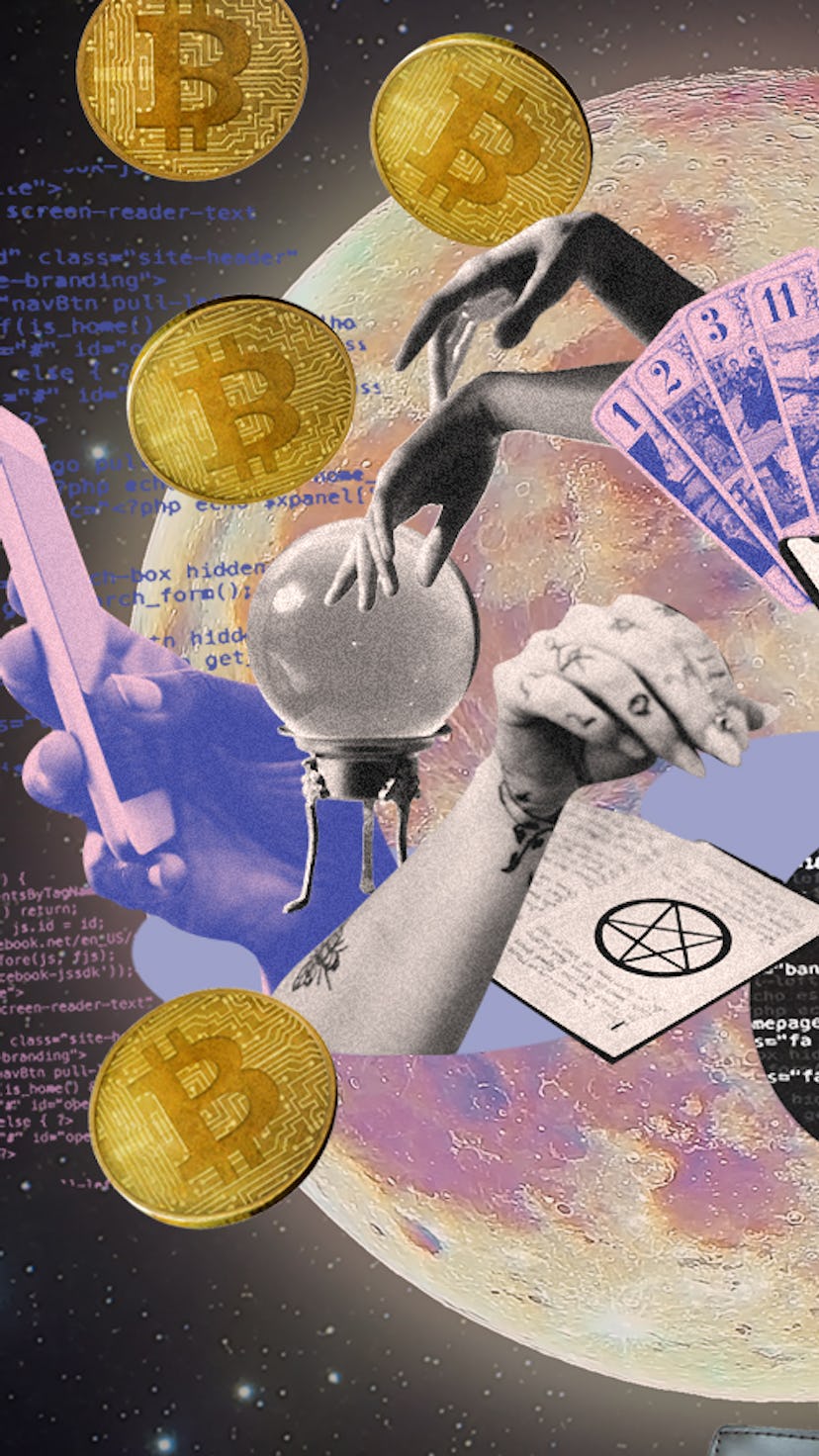Practical Magic
Meet the Crypto Witches Demystifying NFTs
Mystical practitioners are making names for themselves in Web3.

At midnight on Halloween last year, an online collective called Crypto Coven dropped a series of 3,333 code-generated non-fungible tokens (NFTs). They depict playful, pixelated witches that buck against the masculine energy of your typical NFT. Each has their own archetype — a seer, a mage, an occultist, and so on — and astrological birth chart. One witch, for example, named “Elegy, the Stunning Crystal,” is an enchantress with a Leo rising sign. As of mid-March, she was valued at a little over .04 ETH, or $117.
“Witches wander the weird wilds of the world, unafraid and unfettered,” Crypto Coven’s website states. “May you take them into the metaverse and roam.”
Crypto Coven is one of a surprising number of cryptocurrency collectives working at the intersection of mystical arts and Web3. There are witchy educational communities that put out resources to demystify crypto and astrologers who post coin analyses or predictions for the next big wave. The coupling is not intuitive, no pun intended: Witchcraft and astrology are ancient arts that harness the power of Earth’s natural rhythms, while blockchain technology is a new field that has been linked to environmental destruction and, quote, “dumb crypto bros.” Despite this contrast, witches and astrologers are making names for themselves in crypto, using magic and the stars to usher more women into the field, influence the industry, and make a little money in the process.
“In the 1600s, ‘witches’ were financially independent women that were good with herbs and were faced with wild persecution,” says Shirin Carmel Bucknam, co-founder of the online community Crypto Witch Club. “Even now, people still get pissed when women try to claim space or money,” she says. This translates into fewer women getting involved in the nascent industry: A November 2021 Pew Center report found that less than 20% of women age 18-29 have invested in, traded, or used cryptocurrency, compared to over 40% of men the same age.
Founded in August 2021, Crypto Witch Club provides free advice about using blockchain technology and guides blockchain-related brands. Though Bucknam and co-founder Kaitlin McGowan, who previously ran a PR agency together, don’t identify as witches personally, they looked to reclaim those negative associations for good.
What is a DAO if not a kind of technological coven?
Bucknam sees witches as an essential part of the crypto economy. “Part of witchcraft is setting intentions and having an open mind,” the 33-year-old says. “Trusting yourself is important when you enter a volatile market,” she adds, citing the investing maxim “know what you own.” “The open mind part is key, because when learning about blockchain and cryptocurrency, you really have to break your traditional way of thinking.”
On TikTok, astrologer Maren Altman often goes viral for her crypto-related videos. She started investing just before graduating college in 2020, and quickly saw the inefficiencies and “overall bullsh*t red tape of traditional finance,” the 23-year-old tells Bustle. After discovering cryptocurrency, she found she had a knack for trading, thanks to her astrological analysis and technical know-how. Altman believes that part of the reason astrologers, who often don’t have finance backgrounds, can thrive in this space is because there are fewer barriers to entry compared to the legacy financial system, since it’s so new. Money, Altman says, is “energetic management.”
Michelle Pellizzon is the founder of the wellness platform Holisticism, which also provides intuitive financial education. She believes that witches can contribute to the crypto and NFT space because, first of all, we “need more witches everywhere,” she tells Bustle. Witches are the ultimate community builders, she adds, and what is a DAO — aka, a decentralized autonomous organization — if not a kind of technological coven?
“Women and non-binary people who prioritize community care, intuition, healing, pleasure, the planet, and [who] lead with curiosity offer a unique and valuable perspective to this space,” Pellizzon says. Witches may also be drawn to the world of cryptocurrency, she says, as a way to heal “the witch wound,” or a kind of ancestral trauma. Ensuring that witches are “paid for their gifts” is one way to effect that healing, “and NFTs provide a cool way to do that,” she says.
But while some mystical practitioners are excited about the possibilities of Web3, others are more wary of the ethical implications. Amanda Moreno, an astrologer, witch, and member of the International Association of Ethics in Astrology, notes that “both financial astrology and money magic have been around for a long time,” pointing to practices like spellcasting or tracking planetary transits to inform monetary decision-making. Though she affirms that there’s nothing inherently wrong with using astrology or witchcraft for financial benefit, “it is important to consider whether anyone is being harmed or exploited in the process, and what will be done with the gain.”
It’s easy to point to the potential harms of cryptocurrency (hence, the many, many, many skeptics). From an environmental impact standpoint, current cryptocurrencies use enormous amounts of energy to mine, and “it is not ethical to turn a blind eye to that fact,” Moreno says. And because crypto markets are “volatile and high risk, it probably makes more sense to take financial advice from financial advisors instead of astrologers or witches,” she adds.
Still, those on team crypto stress that money is energy, energy is power, and understanding this new field is key to harnessing that power. “The best way to grow our voices, investments, and contribution in the space — from cryptocurrency to Web3 — is to be educated and get involved,” says Bucknam. “The community is what creates the safe space to ask questions and grow and feel confident as an investor.”
She adds: “Major coven vibes."